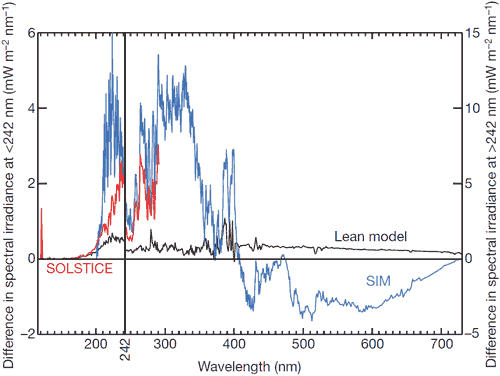
A recently published paper from J. Haigh et al. made it through the media (EurekAlert, CNN) and for a good reason. Indeed, using the data from the new Spectral Irradiance Monitor (SIM) instrument on the SORCE satellite they may have found that the influence of the sun on earth climate is upside down. Scientists and common sense agree that increasing the total solar irradiance warms the earth. On the contrary, the data presented in this paper seem to indicate otherwise.
Before going any further, it is important to quote J. Haigh herself:
"We cannot jump to any conclusions based on what we have found during this comparatively short period and we need to carry out further studies to explore the Sun's activity, and the patterns that we have uncovered, on longer timescales."

Fig. 1: difference in solar spectrum from 2004 to 2007. Note the different left and right scales. (from Haigh et al 2010).
Up to this point, one may think that even if confirmed this effect should not have an impact on the long term trends because of the cyclic behaviour. But what if this behaviour proves to be general and not just related to the 11 years cycle? Given that, for example, part of the warming during the first half of the 20th century has been attributed to an increased sun activity,
Dr Haigh has been very cautious and open to the possibility that it all happened by coincidence::
"[...] if further studies find the same pattern over a longer period of time, this could suggest that we may have overestimated the Sun's role in warming the planet, rather than underestimating it."
"The sun has been behaving very strangely. Its magnetic activity is lower than it has been for several hundred years, perhaps. And so the fact that it's doing strange things in its spectrum is perhaps not that unexpected"One may ask why they published so uncertain results. Haigh gives the answer: "our findings could be too important to not publish them now."
Posted by Riccardo on Tuesday, 12 October, 2010
 |
The Skeptical Science website by Skeptical Science is licensed under a Creative Commons Attribution 3.0 Unported License. |